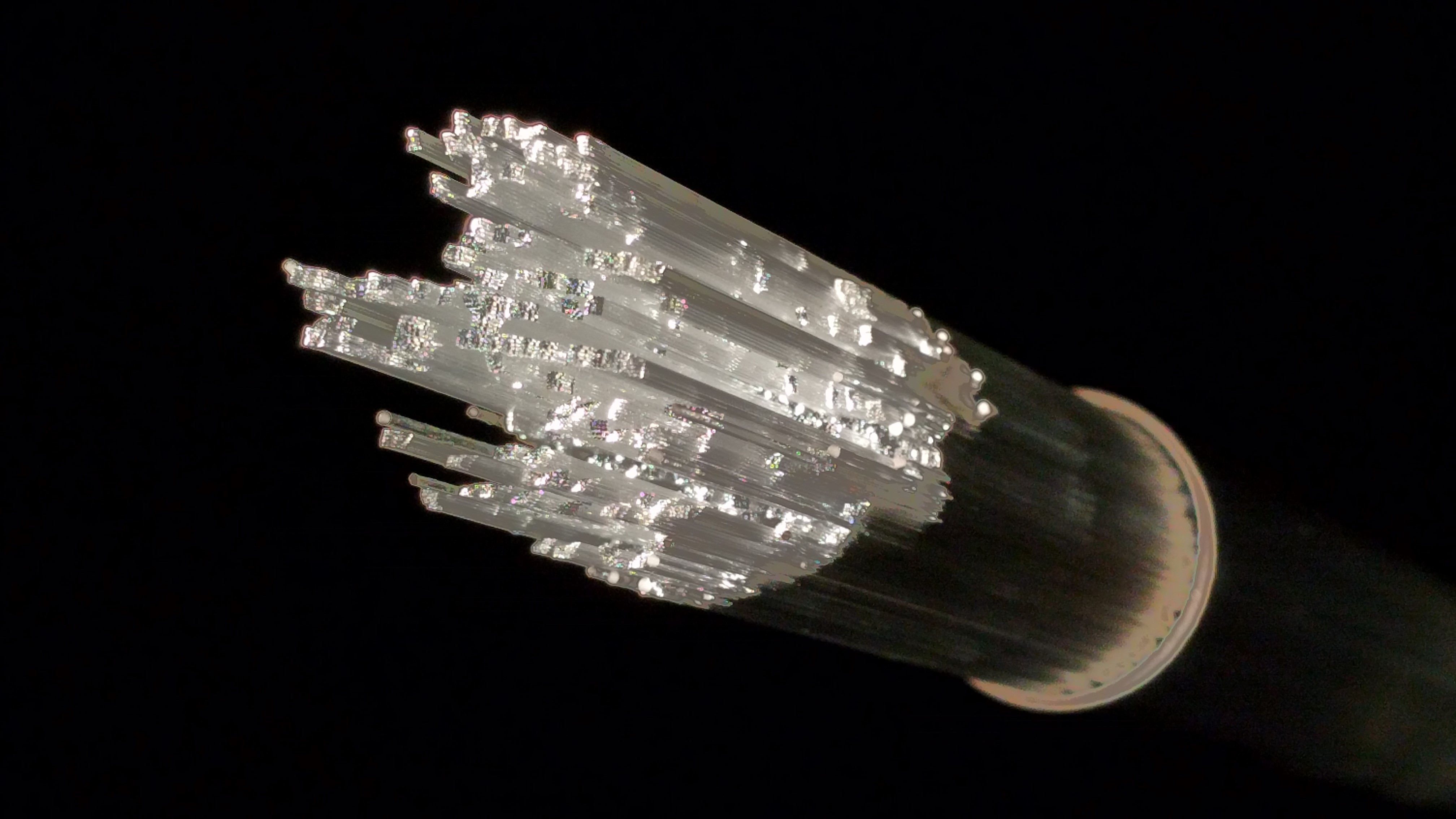Tucked away in the Centre for Photonics and Photonic Materials is an unusual laboratory. In the centre of the room, a metal staircase climbs two stories. It’s flanked by two tall machines, each housing a small, cylindrical furnace. These are the drawing towers, and this is the fibre fabrication facility, a hub of activity where the University’s optical fibre is crafted.
Optical fibre is a thin, flexible strand made from glass that can carry light signals with very little loss of intensity as it passes through. It’s most familiar to us for delivering super-fast broadband to our homes, but our researchers are developing new and exciting ways of using it.
Unlike the solid fibres that carry broadband signals, the fibres crafted in our fabrication facility are predominantly hollow core. This means they’re made up of a series of capillaries arranged around a central void and then fused together into a single fibre.
Much like making a stick of rock, the complex fibres are created from larger, preformed glass rods and stretched out into a thin fibre less than a millimetre wide.
How it works
To begin the process, glass preforms are attached to a chuck at the top of the first drawing tower and lowered at a set rate into the furnace. Reaching around 2000 degrees Celsius, the furnace is hot enough to soften the glass without melting it completely. The first tower is used to create capillaries – thin rods with a hollow centre to them. These capillaries are then slotted into a wider glass tube and arranged in the desired pattern around a central void. The delicate arrangement is fused to create a ‘cane’.
Once the cane is made, it passes to the second drawing tower, where it’s lowered into another furnace. As the glass at the bottom melts, it falls under gravity, pulling the softened glass above into a fine, hair-like strand. A laser beam measures the width of the strand, and it passes into a chamber where a polymer coating is applied and cured, protecting the glass. As the newly-made optical fibre reaches the base of the second tower, it winds through a series of pulleys and is collected onto a spool ready for use.
From an initial metre-long preformed glass rod, researchers can create more than 7km of optical fibre to use in their experiments. Having a fabrication facility on site means that not only can researchers make fibre more quickly and cost-effectively than they can buy it, but they can also design and test their own patterns and configurations. This allows them to try things that have never been done before and compete with researchers across the world for inventive new uses.
Tackling infections in ICU
Dr James Stone and his team also use the facility to make fibres designed for healthcare. Their specialist endoscopes allow clinical teams to access hard-to-reach parts of the body and look at very small areas with microscopic precision.
Working with lung specialists, the team are helping tackle infection in intensive care patients. Already vulnerable to infection, patients' chances of survival drop even further when ventilated. Ventilator-Associated Pneumonia (VAP) is a catch-all term for lung infections in patients on mechanical ventilation, and treatment is harsh. Already weakened patients receive a suite of antifungals and antibiotics in the hope that one will work.
Dr Stone’s specialist fibres can deliver a chemical probe directly to infected areas. The probe lights up in the presence of certain bacteria or fungi. Clinicians can then rapidly identify infection-causing pathogens and deliver more targeted treatments.
The team hopes that more efficient treatment can shorten ICU stays, increasing survival rate and saving healthcare providers tens of thousands of pounds.
Entering the quantum realm
Fibre optics aren’t just revolutionising healthcare. Dr Peter Mosley and his research team are using optical fibres to explore how light could help power the supercomputers of the future.
Unlike conventional computers that store information in a series of ones and zeroes, quantum computers harness the laws of quantum mechanics to create new states. Under certain conditions, individual particles of light, or photons, can become entangled, sharing their properties with one another. Encoding information onto these linked photons turns them into a 'quantum bit'. The particle can simultaneously represent both a one and a zero, opening a new world of processing power.
Dr Mosley and his team have joined researchers from the University of Oxford, exploring how this information can be shared across long distances using a quantum network. Light scatters and loses intensity as it passes through materials, even specialised optical fibres. Certain wavelengths travel through fibres better than others, with infrared going furthest. The team at Bath are exploring how they can change the colour and wavelength of individual photons so information can be optimised for long-distance sharing.
While we're still a long way from seeing this technology in use, its potential power is vast. In the future, quantum computing could help solve logistical problems, encode and decode information, and simulate chemical systems in the drug discovery of tomorrow.
Find out more
Not only is our Fibre Fabrication Facility used by researchers in world-leading research projects, but it’s also available to external clients. We have expertise spanning design, modelling, fabrication and applications of novel optical fibres, and can provide technical support and consultation to external users.
Find out more about our facility and how you can get involved.


